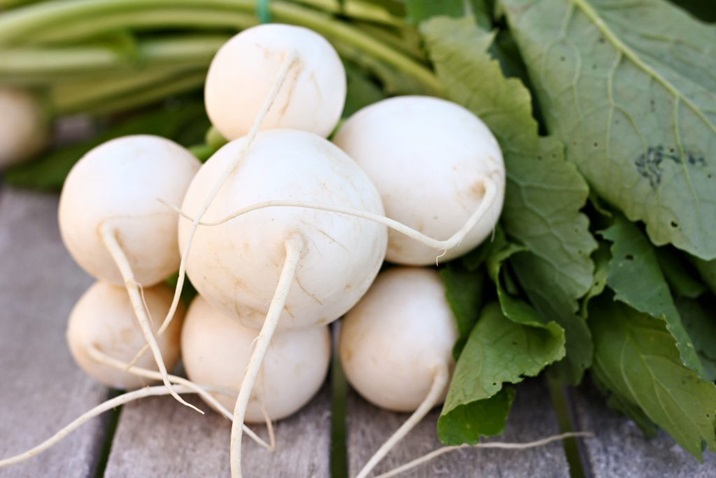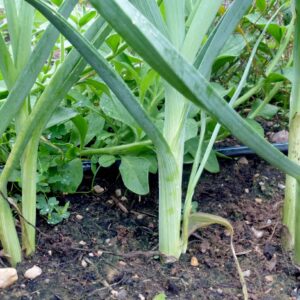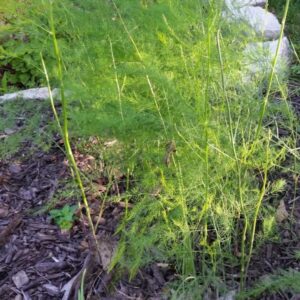Hakurei Turnip
Description
Hakurei turnips are a Japanese variety of turnip known for their small size, smooth white roots, and sweet, crisp texture. Here’s a description:
1. **Size and Shape:** Hakurei turnips are typically small to medium in size, with roots that are round or slightly flattened. They are smaller than traditional turnip varieties, usually ranging from
2 to 3 inches in diameter.
2. **Color:** Hakurei turnips have smooth, creamy white roots with a crisp, tender texture. The skin is thin and delicate, without any roughness or blemishes, giving the turnips a pristine appearance.
3. **Texture:** One of the defining characteristics of Hakurei turnips is their crisp, juicy texture. The flesh is tender and succulent, with a satisfying crunch that makes them ideal for raw consumption.
4. **Flavor:** Hakurei turnips are prized for their mild, sweet flavor with a subtle hint of earthiness. Unlike traditional turnip varieties, which can have a slightly bitter or peppery taste, Hakurei turnips are exceptionally sweet and mild, making them versatile for use in a variety of culinary applications.
5. **Growing Habit:** Hakurei turnips are relatively quick-growing and can be harvested in as little as 30 days from seeding. They are typically grown as a cool-season crop, thriving in the spring and fall when temperatures are mild.
6. **Versatility:** Hakurei turnips are prized for their versatility in the kitchen. They can be eaten
raw as a crunchy, refreshing snack or sliced thinly and added to salads for a sweet, crisp texture. They can also be lightly sautéed, roasted, or pickled to bring out their natural sweetness and flavor.
7. **Nutritional Benefits:** Like all turnips, Hakurei turnips are low in calories and rich in essential
nutrients such as vitamin C, fiber, and antioxidants. They make a nutritious addition to a healthy diet and can be enjoyed in a variety of dishes.
Overall, Hakurei turnips are prized for their delicate flavor, crisp texture, and versatility in the kitchen, making them a favorite among chefs, gardeners, and home cooks alike.
Planting instructions;
To plant Hakurei turnips, follow these planting instructions:
1. **Timing:** Plant Hakurei turnips in early spring for a spring harvest or in late summer for a fall
harvest. Turnips prefer cool weather and can tolerate light frost, so avoid planting them in the heat of summer.
2. **Location:** Select a sunny or partially shaded spot in your garden with well-draining soil. Hakurei turnips prefer loose, fertile soil with a pH between 6.0 and 7.5.
3. **Soil Preparation:** Work the soil to a depth of 6-8 inches, breaking up any clumps and removing rocks or debris. Incorporate organic matter such as compost or aged manure to improve soil fertility and structure.
4. **Planting Depth and Spacing:** Sow Hakurei turnip seeds directly into the prepared soil at a depth of 1/4 to 1/2 inch. Space the seeds 1-2 inches apart in rows spaced 12-18 inches apart. Thin the seedlings to 4-6 inches apart once they have germinated to allow room for the roots to develop.
5. **Watering:** Keep the soil consistently moist but not waterlogged during the germination and
growth stages. Water the turnips deeply once or twice a week, depending on weather conditions and soil moisture levels. Avoid overhead watering to prevent fungal diseases.
6. **Fertilization:** Turnips are moderate feeders and benefit from a balanced fertilizer application before planting. You can also side-dress the plants with compost or a balanced fertilizer once they have established.
7. **Mulching:** Apply a layer of organic mulch, such as straw or shredded leaves, around the base of the turnip plants to help retain moisture, suppress weeds, and regulate soil temperature.
8. **Thinning:** Once the turnip seedlings have emerged and developed their first set of true leaves, thin them to the recommended spacing of 4-6 inches apart. Use scissors or garden shears to carefully remove the excess seedlings, leaving the strongest ones to grow.
9. **Pest and Disease Management:** Keep an eye out for common pests such as flea beetles, aphids, and root maggots, and take appropriate measures to control them if necessary. Rotate crops annually to minimize disease problems.
10. **Harvesting:** Hakurei turnips are ready to harvest when the roots reach a diameter of 2-3 inches, usually about 35-40 days after planting. Use a garden fork or trowel to carefully loosen the soil around the roots and lift them out of the ground. Trim off the tops and store the turnips in a cool, dark place for up to several weeks.
By following these planting instructions, you can successfully grow Hakurei turnips and enjoy their sweet, crisp roots in your garden.





